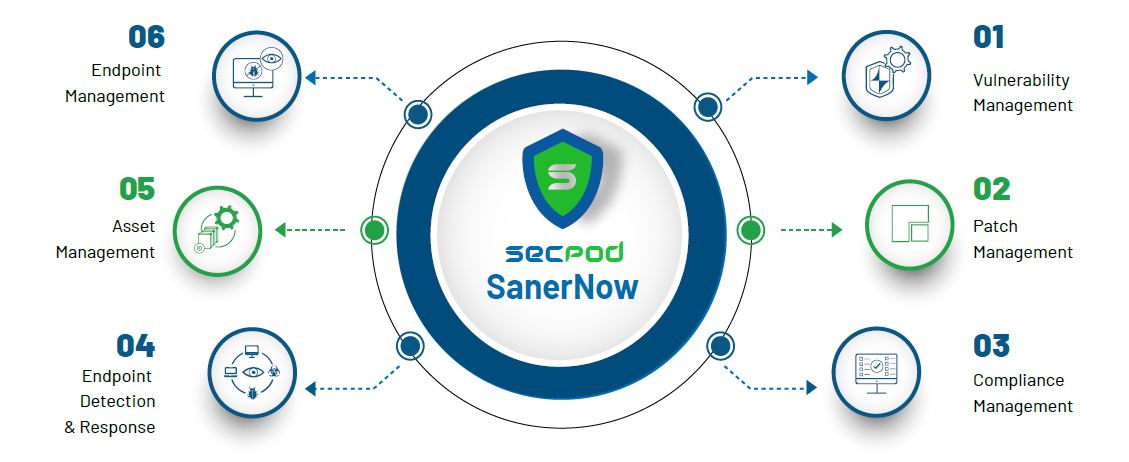An average IT team uses a vast collection of tools and techniques to execute security tasks. A vulnerability management tool, patching tools for different platforms and apps, incident detection and response software, and compliance management software to deal with audits. These tools are their standard security stack. While teams theoretically have all the important tools to execute their primary security tasks, do they still do the job perfectly? This blog covers 5 Setbacks of Multi Tool EndPoint Security Stacks.
Where do multi-tool endpoint security stacks fall behind?
On the surface, separate tools for each security task like patching, vulnerability scanning, checking for compliance, etc., might look like they let you do the job efficiently. If you take a more in-depth look, a series of interwoven problems limit security teams from taking progressive steps and achieving their goals. A patch management tool patches vulnerabilities. Here are the biggest concerns:
1. Struggle to keep up with increasing attacks
In the past two decades, the field that has seen the most evolution is cyber-security. We are in the midst of a rapidly increasing number and complexity of attacks. According to the National Vulnerability Database, the total number of vulnerabilities disclosed in 2020 is 18,356. Up by 6% from 2019 and 11% from 2018. An increasing number of vulnerabilities each year means organizations need to be faster at detecting and mitigating them.
The mean time to patch a vulnerability is between 60 and 150 days. The time taken by hackers for exploiting vulnerabilities can only reduce with growing skills and new tools. All these numbers show that existing tools don’t work well enough with each other to help security professionals detect and mitigate risks before it’s too long.
2. Loosely integrated and incompatible tools
According to a study, only 40 percent of security teams have a single view of the full vulnerability management lifecycle. This lack of a common view obviously attributes to segregated risk management activities in different tools, starting from vulnerability scanning all the way to deploying patches for different platforms.
Different tools for vulnerability detection, assessment, and patching create a discontinuous risk mitigation cycle. It also creates problems during asset discovery when some tools fail to detect a few devices while other tools do.
3. Mushroom management among security teams
Organizations that use multiple tools have a common trait in their security operations. They either stick to fixing specific vulnerabilities, devices, platforms, or just parts of the corporate network. The effect mushroom management, where security team members do not have a clear idea of the big picture, and they are stuck running tasks they are told to do.
If teams used a single tool, they would have access to all patch statistics and the organization’s exact security posture. They would focus on making security tighter instead of accomplishing tasks and calling it a day. In this case, mushroom management doesn’t stem from bad managers but rather from disconnected tools that don’t have space for security teams to collaborate and make their operations more streamlined and efficient.
4. Complications due to remote work
During remote work, a combination of on-premise and cloud security tools are the worst. Admin privileges stuck to specific devices in the case of legacy software. Role-based access eases this problem, but that is not the end of the story.
Remote work has also put limitations on how the employees experience seamless business operations through their devices. Employees expect their devices to function fast and have zero downtime. With multiple security tools come multiple agents installed in each device to carry out specific operations like device scanning, vulnerability scanning, patching, etc. The performance of most devices drops due to multiple agents installed and working at the same time. The last thing an employee wants in the middle of a busy day is to wait forever until each app or file is closed/opened. And that invites an extra ticket to resolve for the IT team.
5. Does not give options to automate routine tasks
Separate tools do not share the same data and architecture, making them almost impossible to integrate well. Rich APIs can offer a little leeway, but they come at a cost. Data about detected risks and the solution-oriented controls always have a wedge between them.
According to a study among IT professionals, 46 percent voted security automation as the preferred tool for improving vulnerability response. Patch automation saves a lot of time and resources for security teams that are better spent on more cognitive tasks. Additional features like continuous vulnerability scanning keep team fatigue at the lowest while having a high-alert approach towards detecting new vulnerabilities.
Drive all endpoint security operations with a platform
All departments are focused on taking their work to centralized platforms. Take sales and marketing, for example. Most teams are looking to consolidate their software tools for enhanced data analytics, faster operations, better decision-making, and healthy collaboration. Why should security operations be any different? It’s time IT helped themselves instead of other departments for a change.
SanerNow Cyberhygiene Platform is the ideal solution to keep all core endpoint security operations on a centralized platform. With SanerNow, you can remotely automate the end-to-end tasks of vulnerability detection up to patch deployment from a centralized console, thereby reducing the multi-tool security stack. It is powered by the world’s largest vulnerability database with over 100,000 security checks and performs lightning-speed vulnerability scans in under 5 minutes. It supports endpoint hardening in alignment with PCI, ISO, HIPAA, NIST standards, and custom policies. The platform also has threat detection and response controls to contain ongoing threats in your environment.
These are the 5 Setbacks of Multi Tool EndPoint Security Stack.
Sign up for a free demo and find out how SanerNow makes your security stack nimble and powerful.


